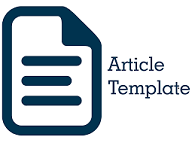Development of Earthquake Disaster Mitigation Learning Program for Early Childhood
Abstract
The danger of earthquakes spread almost all areas of the Indonesian islands, one of them in the city of Padang, West Sumatra either on a small scale to large scale damage. The earthquake was felt not only by adults, but young children are also feeling the impact of the earthquake. So far, efforts to increase the ability of earthquake disaster preparedness much focused on adults, while for young children is still very minimal, it is necessary to provide knowledge of earthquake preparedness in children from an early age. This research is the development by using the 4D model that aims to produce learning programs earthquake disaster mitigation valid, practical, and effective. The data analysis technique used is descriptive qualitative analysis. The conclusion of the development is a learning program earthquake disaster mitigation was very valid and practical use in learning. From the results of studying the implementation of learning programs earthquake disaster mitigation, it was concluded that the child's knowledge and skills regarding earthquake preparedness increases. Thus, learning programs earthquake disaster mitigation is very effective for use in improving the preparedness of children to the earthquake.
Keywords: Learning Program, Disaster Mitigation, Earthquake, Early Childhood
Full Text:
PDFReferences
Ersoy, Ş., & Koçak, A. (2016). Disasters and Earthquake Preparedness of Children and Schools in Istanbul, Turkey. Geomatics, Natural Hazards and Risk, 7(4), 1307–1336. https://doi.org/10.1080/19475705.2015.1060637
Indriasari, F. N. (2018). Pengaruh Pemberian Metode Simulasi Siaga Bencana Gempa Bumi terhadap Kesiapsiagaan Anak di Yogyakarta. Jurnal Keperawatan Soedirman, 11(3), 1–7. https://doi.org/10.20884/1.jks.2016.11.3.700
Mustafa, B. (2010). Analisis Gempa Nias dan Gempa Sumatera Barat dan Kesamaannya yang Tidak Menimbulkan Tsunami. Jurnal Ilmu Fisika | Universitas Andalas, 2(1), 44–50. https://doi.org/10.25077/jif.2.1.44-50.2010
Nurhasanah, N. (2018). Lagu Gempa. Retrieved from http://naninurhasanah.blogspot.com/2018/01/lagu-gempa.html
Oktiari, D., & Manurung, S. (2010). Model Geospasial Potensi Kerentanan Tsunami Kota Padang. Jurnal Meteorologi Dan Geofisika, 11(2), 140–146. https://doi.org/10.31172/jmg.v11i2.73
P2MB. (2010). Pendidikan Mitigasi Bencana. Bandung: Universitas Pendidikan Indonesia.
Setyawan, N., & Khakim, N. (2012). Penyusunan Peta Risiko Bencana Gempabumi Skala Mikro Berdasarkan Kerusakan Bangunan. Jurnal Bumi Indonesia, 1(2), 254–264. Retrieved from http://lib.geo.ugm.ac.id/ojs/index.php/jbi/article/view/30
Setyonegoro, W. (2013). Gempabumi Padang 30 September 2009 dan Potensi Tsunaminya. Buletin Meteorologi Klimatologi Dan Geofisika, 7(3), 163–171. Retrieved from https://www.academia.edu/7677524/GEMPABUMI_PADANG_30_SEPTEMBER_2009_DAN_POTENSI_TSUNAMINYA_Wiko_Setyonegoro_163_GEMPABUMI_PADANG_30_SEPTEMBER_2009_DAN_POTENSI_TSUNAMINYA
Suryana, D. (2009). Model Pembelajaran Siaga Gempa Bumi dan Tsunami di Taman Kanak-kanak: Research and Development di Taman Kanak-kanak Aisyiyah Bustanul Athfal Serang dan Taman Kanak-kanak Al Muhajirin Cilegon Banten. Jakarta: Universitas Negeri Jakarta.
Tuswadi, & Hayashi, T. (2014). Disaster Prevention Education in Merapi Volcano Area Primary Schools: Focusing on Students’ Perception and Teachers’ Performance. In Procedia Environmental Sciences: The 4th International Conference on Sustainable Future for Human Security, SustaiN 2013 (Vol. 20, pp. 668–677). Amsterdam: Elsevier Ltd. https://doi.org/10.1016/j.proenv.2014.03.080
Utama, T. A., Delfina, R., & Saleha, N. (2019). Kesiapsiagaan Masyarakat Lempuing Menghadapi Bencana Gempa Bumi. Jurnal Vokasi Keperawatan (JVK), 2(1), 1–8. https://doi.org/https://doi.org/10.33369/jvk.v2i1.9122
Winarni, E. W. (2016). Pengaruh Pelaksanaan Program Pengurangan Risiko Bencana Terintegrasi Menggunakan Model Problem Based Learning Berbasis ICT Bagi Siswa Kelas IV SD IT IQRA’ 1 di Kota Bengkulu. JINoP (Jurnal Inovasi Pembelajaran), 2(2), 351–359. https://doi.org/10.22219/jinop.v2i2.2626
Winarni, E. W., & Purwandari, E. P. (2018). Disaster Risk Reduction for Earthquake Using Mobile Learning Application to Improve the Students Understanding in Elementary School. Mediterranean Journal of Social Sciences, 9(2), 205–214. https://doi.org/10.2478/mjss-2018-0040
DOI: https://doi.org/10.24036/kolokium-pls.v8i1.387
Refbacks
- There are currently no refbacks.

